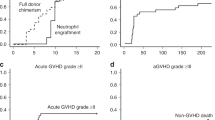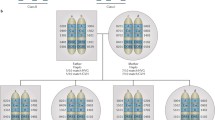Abstract
Thirty patients with hematologic diseases received allogeneic hematopoietic stem cell transplants (HSCT) from related donors other than genotypically HLA-matched siblings. Their outcomes were compared with those of 102 patients who had received HSCT from genotypically HLA-matched siblings. All donors in the study group were HLA-haploidentical relatives.The degree of HLA mismatches in unshared haplotype was 0-locus (n = 6), 1-locus (n = 20), and 2-locus (n = 4). All patients in the study group achieved successful engraftment at a median of 17 days (range, 10-35 days). Grade II-IV and III-IV acute graft-versus-host disease (GVHD) occurred in 16 (53%) and 9 (30%) patients, respectively, in the study group, rates that were significantly higher than those of the control group, which were 33 (33%) and 12 (12%) patients, respectively (P = .034 and .022, respectively). The frequency of chronic GVHD was 85% (22 out of 26 evaluable patients) in the study group, a rate that was also significantly higher than that of the control group with 57% (52 of 91 patients) (P = .0078). The estimated probability of disease-free survival (DFS) for the study group was 56% at 5 years. When the 2 groups were compared according to the risk of disease, the probabilities of DFS at 5 years for patients with low risk in the study and for control groups were 100% and 84%, respectively, and those for patients with high risk were 43% and 42%, respectively.These results showed that the DFS for patients with both low and high risks in the study group was comparable to that of the control group. In conclusion, despite higher probabilities of acute and chronic GVHD, unmanipulated allogeneic HSCT from related donors other than genotypically HLA-matched siblings was considered to be a reasonable alternative for patients without genotypically HLA-matched sibling donors.Int J Hematol. 2002;76:354-359.
Similar content being viewed by others
References
Anasetti C, Amos D, Beatty PG, et al. Effect of HLA compatibility on engraftment of bone marrow transplants in patients with leukemia or lymphoma.N Engl J Med. 1989; 320: 197–204.
Ash RC, Horowitz MM, Gale RP, et al. Bone marrow transplantation from related donors other than HLA-identical siblings: effect of T cell depletion.Bone Marrow Transplant. 1991;7:443–452.
Anasetti C, Beatty PG, Storb R, et al. Effect of HLA incompatibil- ity on graft-versus-host disease, relapse, and survival after marrow transplantation for patients with leukemia or lymphoma.Hum Immunol. 1990;29:79–91.
Szydlo R, Goldman JM, Klein JP, et al. Results of allogeneic bone marrow transplants for leukemia using donors other than HLA-identical siblings.J Clin Oncol. 1997;15:1767–1777.
Ottinger H, Beelen D, Sayer H, et al. Bone marrow transplantation from partially HLA-matched related donors in adults with leukaemia: the experience at the University Hospital of Essen, Germany.Br J Haematol. 1996;92:913–921.
Sasazuki T, Juji T, Morishima Y, et al. Effect of matching of class I HLA alleles on clinical outcome after transplantation of hematopoietic stem cells from an unrelated donor.N Engl J Med. 1998; 339:1177–1185.
Petersdorf EW, Gooley TA, Anasetti C, et al. Optimizing outcome after unrelated marrow transplantation by comprehensive match- ing of HLA class I and II alleles in the donor and recipient.Blood. 1998;92:3515–3520.
Takahashi S, Okamoto SI, Shirafuji N, et al. Recombinant human glycosylated granulocyte colony-stimulating factor (rhG-CSF) combined regimen for allogeneic bone marrow transplantation in refractory acute myeloid leukemia.Bone Marrow Transplant. 1994;13:239–245.
Przepiorka D, Weisdorf D, Martin P, et al. Consensus conference on acute GVHD grading.Bone Marrow Transplant. 1995;15: 825–828.
Shulman HM, Sullivan KM, Weiden PL, et al. Chronic graft-versus- host syndrome in man. A long-term clinicopathologic study of 20 Seattle patients.Am J Med.1980;69:204–217.
Matsumoto K, Horibe K, Akatsuka Y, et al. Bone marrow trans- plantation from donors other than HLA matched siblings for hematological malignancies.Jpn J Clin Hematol. 1994;35:729–737.
Kernan NA, Bartsch G, Ash RC, et al. Analysis of 462 transplantation from unrelated donors facilitated by the National Marrow Donor Program.N Engl J Med. 1993;328:593–602.
Henslee-Downey PJ, Abhyankar SH, Parrish RS, et al. Use of partially mismatched related donors extends access to allogeneic marrow transplant.Blood. 1997;89:3864–3872.
Aversa F, Tabilio A, Velardi A, et al. Treatment of high risk acute leukemia with T-cell-depleted stem cells from related donors with one fully mismatched HLA haplotype.N Engl J Med. 1998;339: 1186–1193.
Rubinstein P, Carrier C, Scaradavouy A, et al. Outcomes among 562 recipients of placental-blood transplants from unrelated donors.N Engl J Med. 1998;339:1565–1577.
Laughlin MJ, Barker J, Bambach B, et al. Hematopoietic engraftment and survival in adult recipients of umbilical-cord blood from unrelated donors.N Engl J Med. 2001;344:1815–1822.
Ooi J, Iseki T, Nagayama H, et al. Unrelated cord blood transplantation for adult patients with myelodysplastic syndrome-related secondary acute myeloid leukaemia.Br J Haematol. 2001;114:1–4.
Author information
Authors and Affiliations
Corresponding author
About this article
Cite this article
Tomonari, A., Iseki, T., Ooi, J. et al. Using Related Donors other Than Genotypically HLA-Matched Siblings in Allogeneic Hematopoietic Stem Cell Transplantation for Hematologic Disease: A Single Institution Experience in Japan. Int J Hematol 76, 354–359 (2002). https://doi.org/10.1007/BF02982696
Received:
Accepted:
Published:
Issue Date:
DOI: https://doi.org/10.1007/BF02982696




